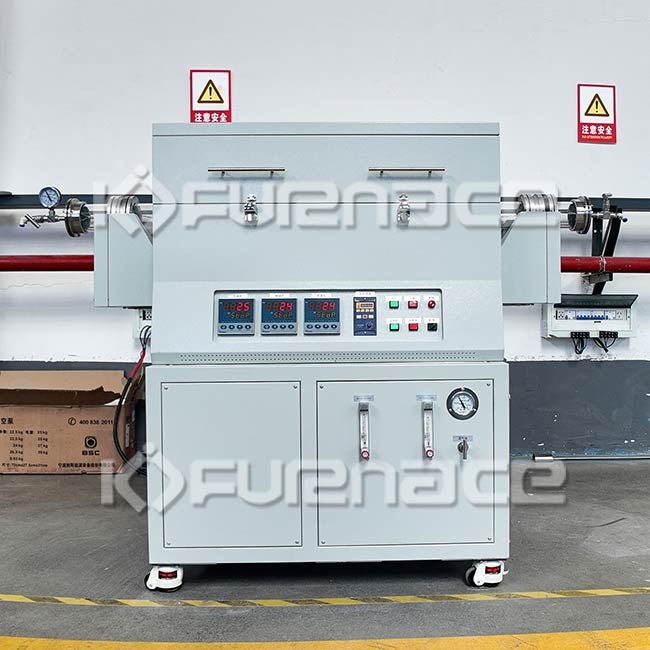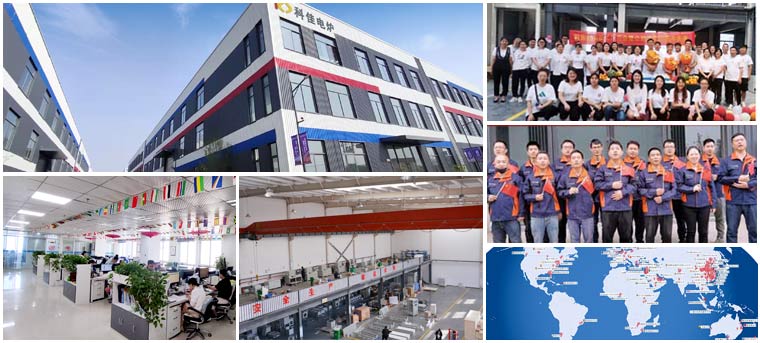Comparative Analysis of Three-Zone Tubular Furnace and Other Furnace Types
As a multi-zone temperature control device, three-zone tubular furnaces differ significantly from single-zone tubular furnaces, dual-zone tubular furnaces, and box furnaces in terms of structural design, temperature control capabilities, and application scenarios. The following comparative analysis focuses on core features, technical specifications, and applicable scenarios.
Ⅰ. Core Features Comparison1. Temperature control capability
•Three-temperature zone tube furnace:
Equipped with three independent heating zones (e.g., 200+200+200mm), the furnace enables precise gradient control of temperature zones (with a temperature control accuracy of ±1°C), supporting step-by-step temperature control for multi-stage reactions or material growth. For example, Westlake University's three-zone tubular furnace can independently set each zone from 0 to 1200°C, with a heating rate of ≤30°C/min, meeting the needs of complex processes.
•Single/double temperature zone tube furnace:
With only 1 to 2 heating zones, the temperature uniformity is relatively high (for example, the constant temperature section length of a single temperature zone can reach 350mm), but multi-gradient temperature distribution cannot be achieved.
• Box furnace:
The whole furnace is heated, and the temperature field is uniform, but there is no zone temperature control capability, which is suitable for batch processing at a single temperature.
2. Structural and functional design
| characteristic |
Three temperature zone tube furnace |
Single/Dual Temperature Zone Tube Furnace |
Box furnace |
| Number of heating zones |
3 independent temperature zones |
1~2 temperature zones |
No partition (overall heating) |
| Vacuum/atmosphere control |
Supports high vacuum (10⁻³Pa) and multi-channel gas mixing (such as 3-channel mass flow meter) |
Partially supports vacuum/atmosphere control, but with fewer gas paths |
Weak atmosphere control capabilities |
| Furnace tube size |
Longer (such as Φ60×1300mm), suitable for continuous experiments |
Medium length (such as Φ80×1000mm) |
No furnace tubes, open furnace |
| Application flexibility |
Multi-step processes (e.g. CVD deposition, gradient sintering) |
Single temperature process (such as annealing, sintering) |
Batch sintering, heat treatment |
Ⅱ. Key Differences in Technical ParametersTaking the tube furnace mentioned in the search results as an example, the core parameters are compared as follows:
| parameter |
Three-temperature zone tube furnace (SGM1200 type) |
Single temperature zone tube furnace (Westlake University TL1200) |
Dual-zone tube furnace (Westlake University TL1200-1200) |
| Rated temperature |
1200℃ (continuous operation 1100℃) |
1200℃ |
1200℃ (dual temperature zone) |
| Heating zone length |
200+200+200mm (three temperature zones) |
80~100mm (single temperature zone) |
80~100mm (dual temperature zone) |
| Constant temperature section length |
350mm (±1°C) |
- |
- |
| power |
Not mentioned (needs to be combined with the number of temperature zones) |
3.5KW |
3.6KW |
| Surface temperature |
≤55℃ (with air cooling system) |
≤35℃ |
|
Ⅲ. Applicable Scenarios and Limitations1. Unique Advantages of Three-Zone Tubular Furnaces
•Gradient material synthesis: Through the temperature difference between three temperature zones, gradient changes in material composition or structure (such as functional gradient ceramics) are achieved.
•CVD experiment: Control the precursor evaporation, reaction and deposition processes in different temperature zones, such as setting the gas source heating, reaction zone and substrate temperature separately in graphene growth.
•Multi-step heat treatment: Continuous processes such as “heating-holding-cooling” or “sintering-reduction-annealing” can be completed without interrupting the experiment.
2. Applicable scenarios of other furnace types
•Single temperature zone tube furnace: suitable for vacuum annealing and simple CVD deposition (such as thin film growth) at a single temperature .
•Box furnace: suitable for scenarios where high temperature uniformity is required but no zoning is required (such as metal material quenching and ceramic sintering).IV. SummaryThe core competitiveness of three-zone tube furnaces lies in their independent temperature control in multiple zones and their compatibility with complex processes. They are particularly well-suited for new material research and development (such as nanomaterials and semiconductor thin films) in universities and research institutes, as well as chemical reactions requiring precise gradient control. Single- and dual-zone tube furnaces and box furnaces, on the other hand, offer greater economical and efficient advantages for single-temperature processes or batch processing. The choice should be made based on the complexity of the temperature gradient, the precision of atmosphere control, and the sample volume required for the experiment. 
![]() Send E-mail:web@kejiafurnace.com
Send E-mail:web@kejiafurnace.com![]() Wechat/Whatsapp: +86 18037178440
Wechat/Whatsapp: +86 18037178440![]() Company Tell: +(86)18037178440
Company Tell: +(86)18037178440

 E-mail:web@kejiafurnace.com
E-mail:web@kejiafurnace.com
 Tell:+(86) 18037178440
Tell:+(86) 18037178440
 Whatapp:+(86) 180-3717-8440
Whatapp:+(86) 180-3717-8440
 Address:Room 1505, Building 9, No. 26 Dongqing Street, Zhengzhou High-tech Industrial Development Zone
Address:Room 1505, Building 9, No. 26 Dongqing Street, Zhengzhou High-tech Industrial Development Zone


 Website navigation
Website navigation
 Position:
Position:





